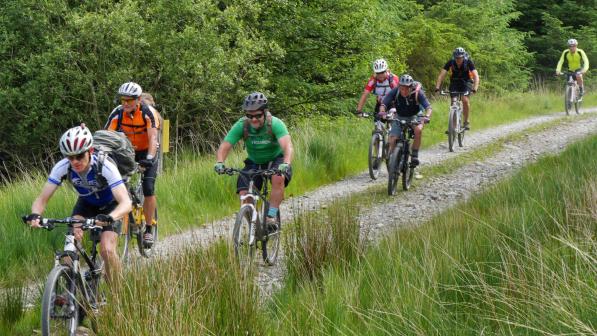Cycling in Gwynedd, Anglesey and Snowdonia

Snowdonia and the north west coast offer some fantastic road and family cycling, as well as renowned mountain bike trails at Coed-y-Brenin, north of Dolgellau. The mountain, lake and sea views are spectacular, and Welsh culture thrives here: you’ll hear yr hen iaith (‘the ancient language’) spoken everywhere.
One of Britain’s very best family rides is the Mawwdach Trail (part of NCN8), running 10 miles from the seaside town of Barmouth (which has a mainline station) to the outdoor hub of Dolgellau. It crosses the Mawddach Estuary on a remarkable Victorian wooden bridge – a wonder in itself – and then runs scenically alongside the water. Further north, a similar length stretch of NCN8 south of Caernarfon is another child-friendly railtrail. A speciality of this part of Wales is heritage railways – the Ffestiniog for example – and most take bikes and make a good family trip.
That NCN8 actually runs from Cardiff to Holyhead and is the Lôn Las Cymru, the Welsh top-to-bottom whose 250 miles gives a thrilling overview of the country in all its guises, geographical and social. It’s a great week’s challenge for the tourer. One highlight is the crossing of the historic Menai Bridge, after which quiet roads take you to Anglesey (and the ferry to Ireland) by way of a selfie stop at Llanfairpwllgwyngyllgogerychwyrndrobwllllantysiliogogogoch.
Road cyclists will love the mountain and reservoir roads around south Snowdonia. Highlights include the pass of Bwlch-y-Groes, east of Dolgellau, rising to 580m (1,900 feet); the remote roads north east of Coed-y-Brenin; and the circuits of Bala and Vyrnwy lakes. The area round Tywyn is great too (but you need a full-suspension mountain bike for NCN82). These are possibly more pleasant options than cycling central Snowdonia itself, where roads are few and busy (such as the awesome Llanberis Pass) and it’s primarily walking rather than cycling country.
Cycling groups and clubs in Gwynedd, Anglesey and Snowdonia
Chester and North Wales CTC (Chester)
http://www.cyclinguk.org/local-groups/chester-and-north-wales-ctc-caer-gogledd-cymru
http://www.ctcchesterandnwales.org.uk/
Rides of all types in some of Britain’s finest scenery
CMC Adventure (Llanbedr)
http://www.cyclinguk.org/local-groups/cmc
https://www.facebook.com/CMC-Adventure-200736029951585/
Enabling young people to have outdoor adventures in amazing scenery
Beicio Bangor (Bangor)
http://www.cyclinguk.org/local-groups/beicio-bangor
http://www.beiciobangor.org.uk/index.asp
Campaigning for cyclists in our area / Cefnogi beicio yn ein ardal ni
Holyhead Cycling Club / Clwb Seiclo Caergybi (Holyhead)
http://www.cyclinguk.org/local-groups/holyhead-cycling-club
http://www.holyheadcyclingclub.co.uk
Sunday club rides and more for riders of all abilities
What to take with you on your ride
The only thing you really need for cycling is a bike. And maybe a phone, and credit card: in Britain you’re only a call away from any service you might need.
But unless money is no object, it’s wise to take a few things with you on a day ride. A saddlebag, panniers or bikepacking bags are best for carrying stuff. A front basket is second best. A rucksack is third best. Your sweaty back will soon tell you why.
Cycling short distances in jeans and t-shirt is fine, but on a long or strenuous ride – over ten miles say, or in hills – those jeans will rub and the t-shirt will get damp and clingy. Shorts or, yes, lycra leggings and padded shorts will be much comfier, and merino or polyester cycling tops wick away the sweat, keeping you dry and comfy. (They don’t have to be lurid colours.)
If rain’s in the air, pack a rainproof top. If it might turn chilly, take a fleece or warm top. But the thing you’re most likely to forget is the sunblock.
It’s remarkable how often you enjoy being out on the bike so much that you suddenly realise it’s getting dark. So take lights (which are legally required at night). They’re price of a sandwich, take no space, are easy to put on thanks to tool-free plastic clips, and the batteries last for ever.
Take a puncture repair kit (with tyre levers) and pump. Make sure it fits your valves, which will be either ‘Presta’ or ‘Schraeder’ – realising they don’t match is a very common roadside discovery! Carrying a spare inner tube (make sure it matches your tyre size) makes puncture repair much easier: mend the old one back at home. If you do get in trouble, some kindly passing cyclist will probably stop to help.
Using a helmet is a personal choice – they’re not legally required.
Cycling makes you thirsty, so take lots of water. Long-distance riders talk about ‘the bonk’ – a sudden loss of energy rendering you almost stationary. It’s miraculously and instantly cured by eating something sweet. On short rides you’re unlikely to run out of energy, but just in case, take a snack like flapjack, banana, chocolate or jelly babies.
Taking a packed lunch or picnic will save you money, though that hot drink and cake in a cosy cafe could yet prove very tempting!
Your phone GPS could be invaluable for showing where you are when lost; you can download free detailed UK maps and GPS software before your trip.
Paper maps are still useful, though, so take one: no power source or wifi signal required, and they’re great for suggesting possibilities or changes of plan.



